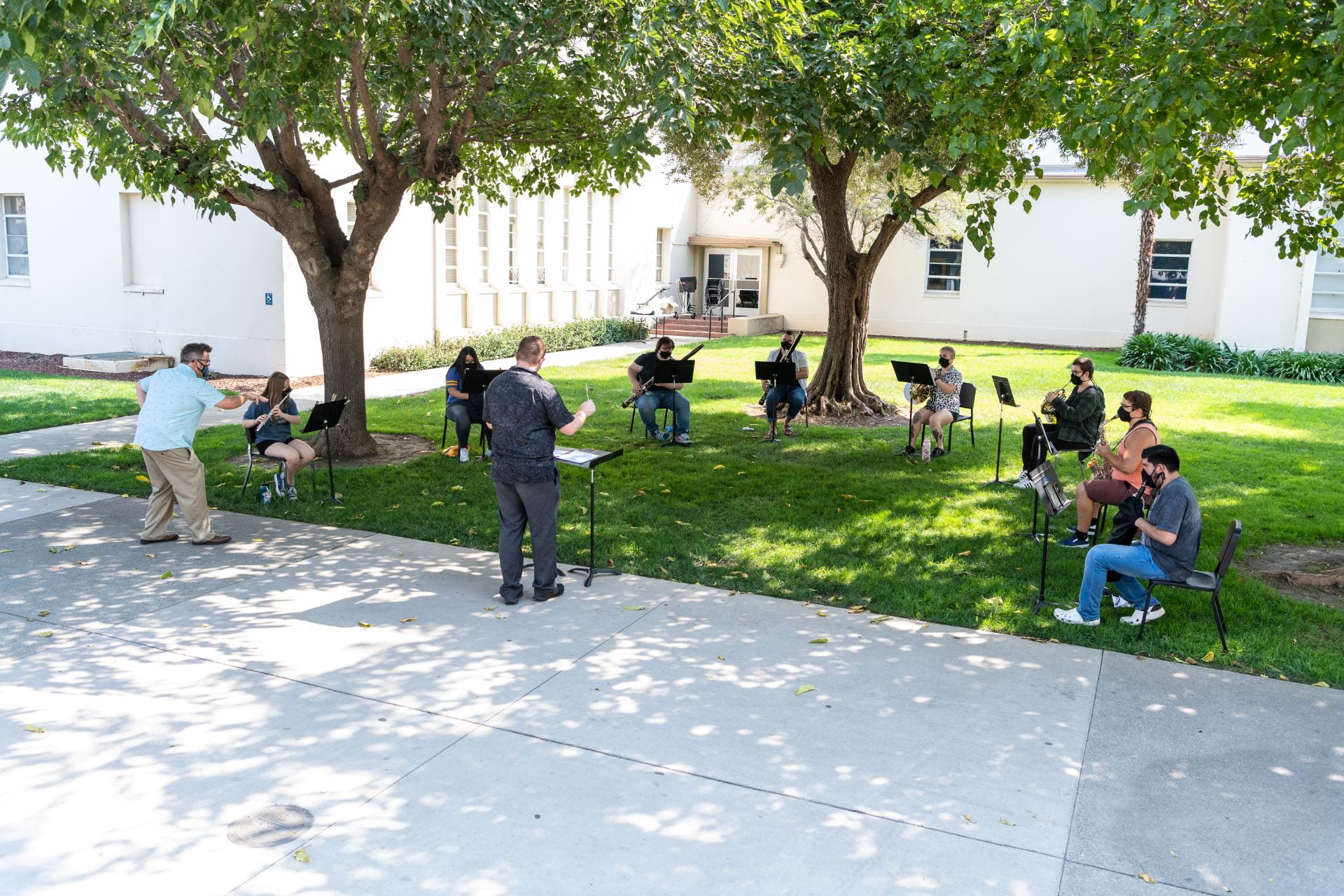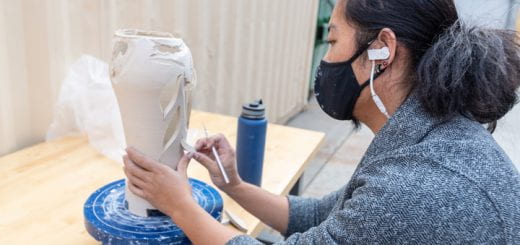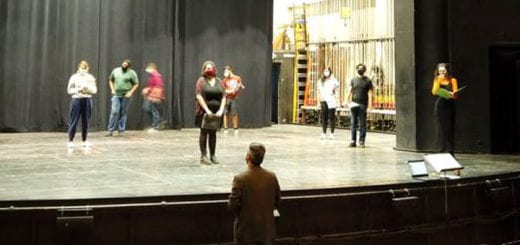Persistence and “The Pride of the Spartans”
The Spartan Marching Band and Color Guard wasn’t permitted to hit the field this fall—but they’re still performing instead of giving up and disbanding.
Directed by Craig McKenzie, the marching band has crumpled and redrawn its drill charts multiple times during 2020. When the football season was postponed, performing in the stadium was off. But the show—and the departmental mission, wherein “music and dance are essential expressions of human experience”—must go on.
To prepare, the music department came up with a creative solution: a practice space on the fifth floor of the 10th Street parking garage. Two 5,000-square-foot spaces for dance and ensembles have been fenced off. Air flows through, but there’s protection from the elements—and musicians and dancers can also stay protected from contagion.
Marching band planned on using the garage space, McKenzie says, but reconsidered, “The way the sound echoes, and the difficulty we had in getting all of our large equipment over there,” influenced the decision. Shifting restrictions required enormous flexibility; plans kept changing. “Back in August and the beginning of September, we were under the impression the band would play at games in October,” he says. “We started virtually with the intent of using the parking garage and some other facilities to prepare. Then the Mountain West canceled all games until January. At that point, because we’d started virtually, we decided to focus on that. Creating audiovisual material would help us in the long term with recruiting, and if athletics needed audiovisual materials from us. We put all our eggs into that basket at that time.”
Then the conference decided football was back on—with the first game on October 24. Yet the band would not be allowed in person.
“It’s been a moving target,” McKenzie says. “Through all of that, we have remained as a marching band, meeting virtually. Band members record themselves individually, and then we compile video performances where all the student musicians are playing together at the same time, even though they’re recorded from home.” McKenzie says it’s better than football without band. “It’s such a tradition tied to college football. Not to have even a virtual presence at the games would be really disappointing for all of the alumni and all the people who love the band. So we’re happy that we can participate in some way.”
The Wednesday before the first football game, a few band members assembled in the stadium and recorded a music video of the fight song. The video played in CEFCU Stadium during the 17-6 upset win over Air Force, as fans and the band alike participated from a distance. In true 2020 style, the Pride of the Spartans were present for the game.
Creativity to Get Beyond the Screen
“The basic principle in music and dance is really simple,” says Music Professor Fred Cohen, director of the School of Music and Dance. “We’re all about experiential learning. It’s activity-based, you make music, you dance. You can’t do it very effectively behind the TV screen of any kind. It just doesn’t work. So we just have to figure out a way of safely getting people together. What we’ve learned is that we’re best off outside.”

A Chamber Music classes practices a piece outside the Music Building, near the Cesar Chavaz Arch on the SJSU Campus, Monday, September 28, 2020. Photo by Robert C. Bain, University Photographer.
Wind and brass players projecting aerosolized breath are potential contaminant spreaders, Cohen says. Those performers are safest moving outside. Guidance from national music associations suggested flutes sprayed the least aerosol, trombones the most. McKenzie said Director of Bands David Vickerman found special masks with mouthpiece slots, and special bell covers so instruments don’t spray aerosolized breath. Brass players empty spit valves onto absorbent cloths designed for dog training, called “puppy pads.” Cohen says, “The more we know, the more cautious we have to be. We’ve learned that the aerosol particles travel much farther than six feet.”
At first, marching band will be standing still. McKenzie is assembling a project using four new high-quality video cameras and existing audio equipment. The August fires that closed campus further delayed the band leaders’ plans, but, Cohen says, “We’ve come up with something creative that involves movement.” A sophisticated video production will present “marching band in the time of COVID-19,” he says.
The music program hosts over 20 ensembles that usually perform 120 times a year. The Choraliers, SJSU’s top choral ensemble, for which both undergraduates and graduate students must audition, have performed their wide-ranging repertoire nationally and internationally at the highest level of the choral art. Other vocal ensembles include the Concert Choir, Spartan Glee Club, Spartones, Vocal Jazz Ensemble, Treble Choir and Opera Theater. There will be the wind and percussion ensembles, and Collegium Musicum, an instrumental and vocal ensemble performing music from the Middle Ages, Renaissance and early Baroque eras.
The Choraliers, numbering about 30, were practicing in groups of four to eight. Cohen says post-production video would shape the product of the ensemble. “Everyone will be singing, but not simultaneously, it’ll be done post-production.” To match tempo, Cohen says, vocalists would use click tracks, precisely calibrated metronomes. “We’re trying to be creative so it doesn’t look like a Zoom meeting where everyone has their own square.”
The performance dance majors of University Dance Theater practiced together in “pods” of four to six dancers. Cohen says to reduce risk and form a COVID-19-safe cohort, the dancers in each pod also lived together, in dorms or off campus. Newly installed in 10th Street Garage is a “sprung floor” to dance on safely, preventing injuries.
In spring 2020, Cohen says, the performing arts came to a brutally sudden stop: “No one did anything with any other human being [in person].” For fall, solutions had to reconvene students to join in creative performance—without risking virus spread.
Students are back—and desperate for interaction. “They want to sing, they want to play, they want to dance. But we do it in small groups,” Cohen says. “The campus is relatively empty, so they can practice dance outside on lawns and other places, which I think will actually be something lovely for the campus.” For example, Clamber, choreographed by Heather Cooper and Raphael Boumaila, was performed and filmed outdoors on campus, with selected portions of familiar buildings as backdrops.
The semester of unprecedented challenges had begun well, given the restrictions, Cohen says. “Thus far people really want to come in and make music and dance together. I haven’t had students be anything but enthusiastic. They want to be in the ensembles, marching band and choir. They’re really looking forward to doing things. And so the faculty members are working really hard to arrange it so that it’s safe.”
For marching band, McKenzie says, “Everybody realizes that we’re taking precautions because we want to keep everybody safe. At the end of the day, my rule of thumb this whole semester has been, ‘How do we do this and keep everybody as safe as possible at the same time? And I’m always going to err on the side of caution.”
Thirsting for collaborative performance, but playing it safe—a tall order. “We’re taking every precaution we can take, trying to serve the students,” Cohen says. “Because this is what they want to do—to serve our art and keep people safe at the same time. It’s a balancing act.”
Cohen empathizes with his young performers. “A lot of these students don’t want to be alone anymore. In music and dance, the social piece of making art is huge. We don’t measure it, typically, but I think that’s driving a lot of students.”
As always, Cohen says, students devote hours to practicing alone. “But the reason you do that is so that when you get with somebody, this other thing happens. And they’re hungry for that,” Cohen says. “As are we all.”



